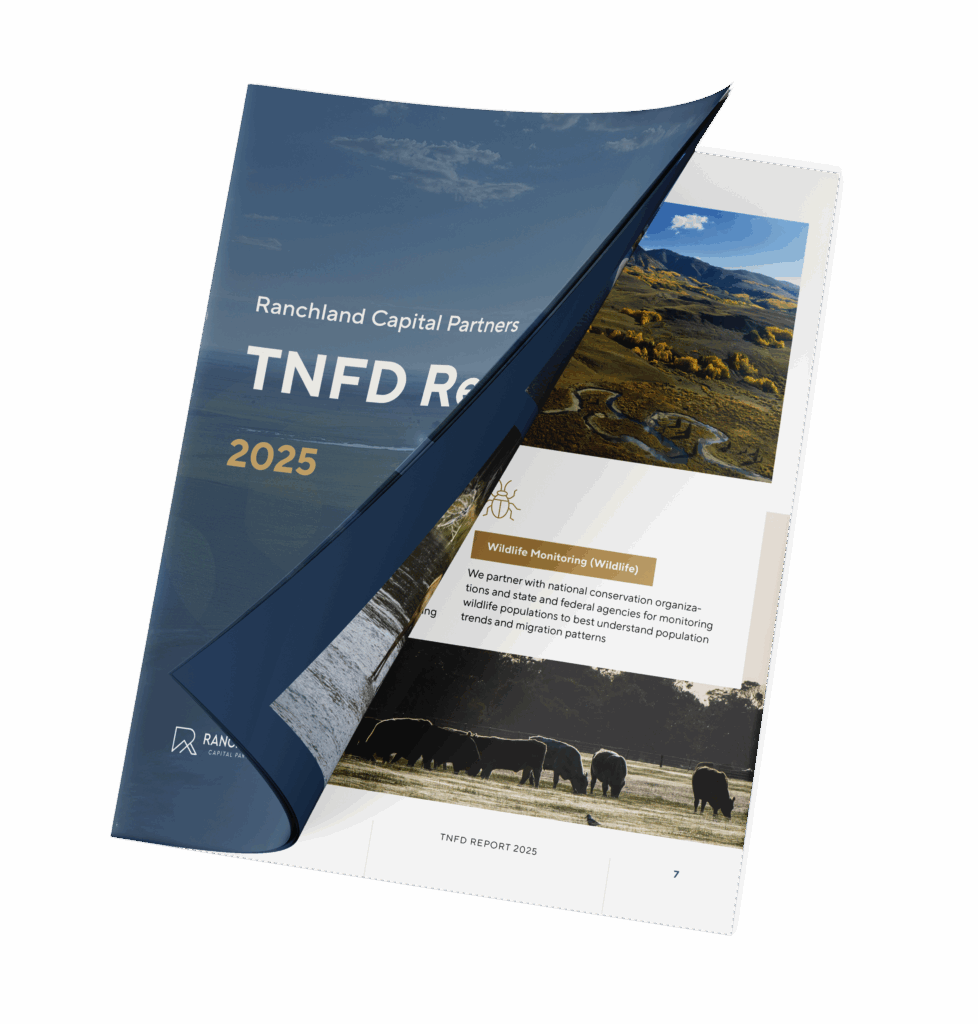Since 2025, Ranchland Capital Partners has published its Annual TNFD Report, outlining our framework for integrating nature-related risk and opportunity assessment into our inves tment process. This inaugural report es tablishes how we are aligning with global s tandards for natural capital disclosure and setting measurable goals for ecological performance across our managed ranchlands and operating partnerships.

Evidence-Based Sustainability®
Driving Positive
Change in Grassland
Ecosystems
We seek to drive positive impact across the four core pillars of ranchland ecosystems, promoting increased land health, soil health, water resources, and wildlife habitat, by combining passive ownership with active, ecologically focused management.
We have a notable opportunity to align with our investors and the industry on sustainability, and our goal is to ensure that these vital lands continue to thrive and contribute to global food security and environmental stability for future generations.
Underperforming
Improving
Outperforming
The Land
The Soil
The Water
The Wildlife
Evidence-Based Sustainability®
Ecological Performance Drives
Financial Performance
We use an Evidence-Based Sustainability® approach, a scientifically rigorous three-step process that includes quantitative data collection, analysis, and reporting.
This framework is essential for making informed management decisions that drive both ecological and financial performance, while also delivering on our commitment to accountability for our management actions on each property.

Evidence-Based
Sustainability®
1/3
Data Collection
Plants
For the plant segment, we use a well-established approach called Rangeland Health Monitoring. This quantitative process, developed by leading land health experts, assesses over 14 rangeland KPIs including plant community composition, plant productivity, ground cover, and erosion.
Animals
For wildlife, we partner with national conservation organizations and state and federal agencies for monitoring wildlife populations to best understand population trends and migration patterns.
Water
For water, we utilize federal riparian condition protocols to measure the health of waterways. These include evaluations of stream bank stability, stream health, and wetland conditions, providing a comprehensive view of water resources.
Soil
For soil, we deploy Soil Health Monitoring programs, utilizing validated protocols developed by soil science experts. Through this monitoring process, we evaluate over 18 KPIs, including soil microbial activity, respiration, and carbon-to-nitrogen ratios, which reflect soil’s capacity to support plant growth.
2/3
Analysis
3/3
Reporting
Plants
Animals
Water
Soil
01 /
Bare Ground
02 /
Erosion
03 /
Plant Pedestaling
04 /
Litter Amount
05 /
Litter Distribution
06 /
Litter Incorporation
07 /
Dung Breakdown
08 /
Percent Desirable Plants
09 /
Age Class Distribution of Desired Species
10 /
Plant Species Diversity & Functionality
11 /
Living Organisms
12 /
Plant Canopy
13 /
Plant Vigor
14 /
Plant Distribution
01 /
Forage-to-cover ratio
02 /
Wildlife Agency Population Surveys
03 /
Bird Species and Population Index
01 /
Streambank Stability
Streambank ability to resist erosion
02 /
Sediment Capture
Ability of the system to capture and store sediment.
03 /
Floodplain Health
Overview of system integrity
04 /
Vegetation Health
The presence and vigor of plants that stabilize banks and provide habitat.
01 /
Overall Soil Health
02 /
Respiration CO2-C
03 /
Water Extractable Organic Carbon
(WEOC)
04 /
Water Extractable Organic Nitrogen
(WEON)
05 /
Ratio of WEON to WEOC
(C:N)
06 /
Microbially Active Carbon
(%MAC)
07 /
Organic N Release
08 /
Organic N Reserve
Plants
Animals
Water
Soil

Plants
Animals
Water
Soil
Soil Health
Rangeland Health
Wildlife
Habitat
Riparian & Wetland Condition
Water Quality
Fishery
Water Sources & Uses
Data Collection
Analysis
Reporting
Plants
For the plant segment, we use a well-established approach called Rangeland Health Monitoring. This quantitative process, developed by leading land health experts, assesses over 14 rangeland KPIs including plant community composition, plant productivity, ground cover, and erosion.
Animals
For wildlife, we partner with national conservation organizations and state and federal agencies for monitoring wildlife populations to best understand population trends and migration patterns.
Water
For water, we utilize federal riparian condition protocols to measure the health of waterways. These include evaluations of stream bank stability, stream health, and wetland conditions, providing a comprehensive view of water resources.
Soil
For soil, we deploy Soil Health Monitoring programs, utilizing validated protocols developed by soil science experts. Through this monitoring process, we evaluate over 18 KPIs, including soil microbial activity, respiration, and carbon-to-nitrogen ratios, which reflect soil’s capacity to support plant growth.


Conservation
Prioritizing Land Health
America’s grasslands are among the most endangered ecosystems on the planet, with continued annual losses in wildlife habitat, soil health, and biodiversity.
These vast expanses of ranchland play a critical role in maintaining ecological balance, supporting a diverse range of species, and contributing significantly to global food security, and today, we risk losing the essential ecosystem functions they provide.

Our Mission
The world is losing biodiversity at an alarming rate. At RCP, we want to reverse this trend by connecting
scalable investment capital with cutting edge land management.
1/3
Improve
Ecological Trends
We manage natural resources to pursue continuous upward trends in ecological function. Management practices are geared toward constantly improving the overall health of natural resources through time.
2/3
Thriving
Ecosystems
A fully functioning ecosystem is portrayed by the integrity of the soil, vegetation, water, and wildlife, as well as that system’s ability to replenish itself. Our stewardship practices focus on creating systems of high ecological integrity capable of withstanding systemic disturbances.
3/3
Cash Flow
For conservation practices to be more broadly accepted, they must be profitable. Our work focuses on healthy land management practices that have the potential to financially support the larger ecosystem and surrounding community.
Responsible and Sustainable Investing
Our Commitments
Animal Welfare
Ranchland adheres to the following protocols to prioritize
the humane treatment of animals on ranchlands:
Ranchland Capital Partners TNFD Report
